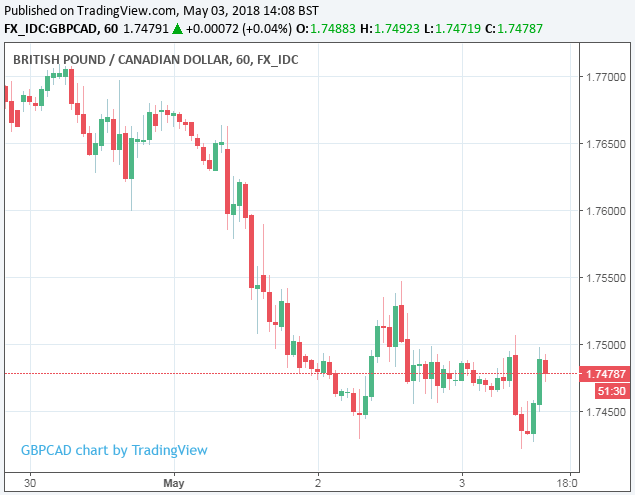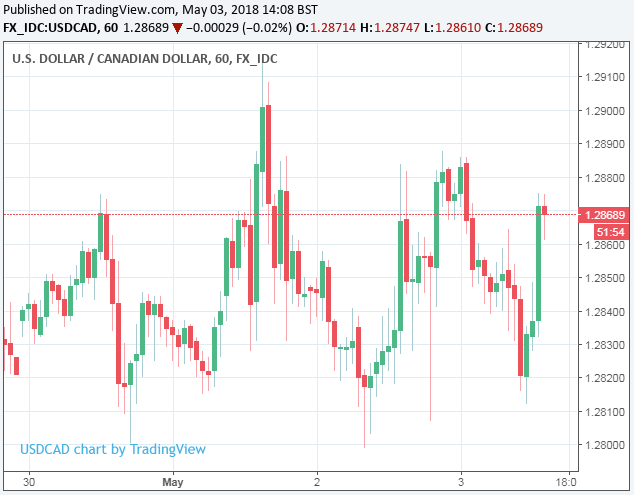Canadian Dollar Slumps after Trade Deficit Hits Record in March but There's a Silver Lining in the Data
- Written by: James Skinner
-
-CAD pares gains over majors after trade deficit hits record in March.
-Silver lining is record imports suggests robust domestic demand.
-But elusive NAFTA deal and BoC policy uncertainty still a constraint.

© Fresh Idea, Adobe Stock
The Canadian Dollar pared back earlier gains over the majors Thursday as markets responded to data showing a steep widening in the Canadian trade deficit, to record levels, during March.
Canada's trade deficit widened to -$4.2 billion at the end of the first quarter, from a revised-$2.9 billion deficit in February, when markets had been looking for the mismatch to narrow to -$2.3 billion. Previously, the February deficit was thought to have been -$2.7 billion.
The deterioration resulted from a sharp rise in the value of Canada's imports during the month, to a record of $51.7 billion, coming against a slower 3.7% rise in exports to $47.6 billion.
"In what was expected to be a mundane release, the trade deficit widened to a record level in March," says Royce Mendes, an economist at CIBC Capital Markets. "The news on a wider trade deficit is weighing on the Canadian dollar, but this report actually seems like good news from a GDP perspective given what it implies for domestic demand."
Thursday's trade balance data matters to markets because it provides insight into real-economy demand for the Loonie and gives a steer on the likely pace of GDP growth in the first quarter. Economic growth is relevant to market expectations for Bank of Canada monetary policy. As it stands, both exports and imports grew during the month, which is important for different reasons.
Imports are a subtraction in the calculation of GDP so, on the face of it, the March increase would appear to be negative for first quarter growth. But turned on its head, the March surge in imports can also be taken as a sign of a robust domestic economy. Exports, which also rose in March, will are a positivie influence on GDP.

Above: Pound-to-Canadian-Dollar rate shown at hourly intervals.
The USD/CAD rate was quoted 0.24% lower at 1.2852 following the release, after paring back a larger loss, while the Pound-to-Canadian-Dollar rate was unchanged for the session at 1.7484 after having reversed a 0.26% loss.
"USDCAD is steady in the 1.2800-1.2900 range and needing a boost soon to keep the rally going, though we prefer the USD against most other pairs even if the rally extends," says John Hardy, chief FX strategist at Saxo Bank.

Above: USD/CAD rate shown at hourly intervals.
Bank of Canada in Focus
Thursday's trade figures come hard on the heels of GDP data that showed the Canadian economy rebounding from an earlier slump during February. Canada's economy expanded 0.4% during the month, more than reversing the 0.1% decline seen back in January.
This has left some economist estimates of first-quarter growth running a touch above the Bank of Canada forecast for an expansion of just 1.3% and has led strategists to begin eyeing the July policy meeting for another interest rate hike. Although that being said, all economist forecasts point to slower growth in Canada when the first quarter.
"The numbers offer a good hand-off to projections for the start of the year, though the broader story is that the economy is still decelerating and the Bank wants the economy to run hot. For now, the market is focused on pricing between the May and July meetings, and we lean towards the latter," says TD's Demers.
The Bank of Canada held its interest rate steady at 1.25% at the end of April and has signalled to markets that it is concerned about more than just a first quarter slowdown, with the NAFTA renegotiation and recent trade tensions between the US and China both weighing on policymakers' minds.
"We see lots of risk events for the loonie over the coming weeks that favour some upside in the crosses – namely, 1) NAFTA and 2) the Iran nuclear deal," Demers adds.
NAFTA Deal Remains Elusive
Canada, Mexico and the US have been attempting to renegotiate the North American Free Trade Agreement for almost a year now and, according to many of the latest reports, are beginning to make some progress. However, a firm deal is yet to be reached.
This is important given analysts have previously estimated that a NAFTA withdrawal by the US could hit the Canadian economy hard and see the Loonie fall by as much as 20%. Conversely, the Loonie could also rise strongly if and when a deal is clinched.
"If the negotiations really were to drag on until year-end that would no doubt be a bad sign for the Canadian currency. We expect that the USD-CAD exchange rate – driven by a stronger USD – will be under upside pressure in any case over the coming months," says Thu Lan Nguyen, an analyst at Commerzbank.
Campaigning for the July Mexican Presidential election got underway at the end of March and is expected to increasingly become an impediment to the talks continuing as the date draws closer while later in the year, approaching November, the US midterms could also prove a political distraction. Fears are that these events will lead the NAFTA negotiations to drag on until the end of the year.
"So far we had only expected a very moderate uptrend as we assumed that the Bank of Canada would continue to hike interest rates, thus supporting the currency. But that is by no means certain if the NAFTA uncertainty was to continue and put pressure on the economic outlook," Lan Nguyen says, of the outlook for USD/CAD.
Advertisement
Get up to 5% more foreign exchange by using a specialist provider to get closer to the real market rate and avoid the gaping spreads charged by your bank when providing currency. Learn more here.









